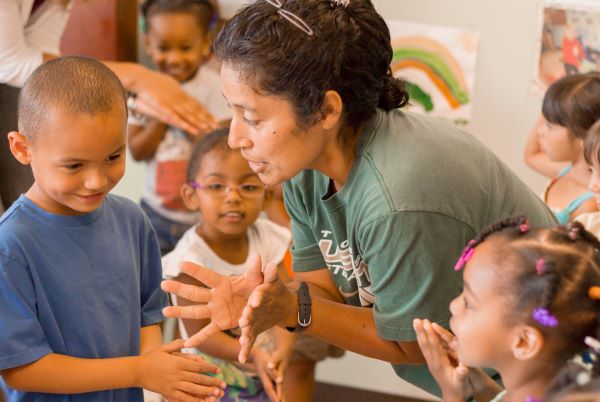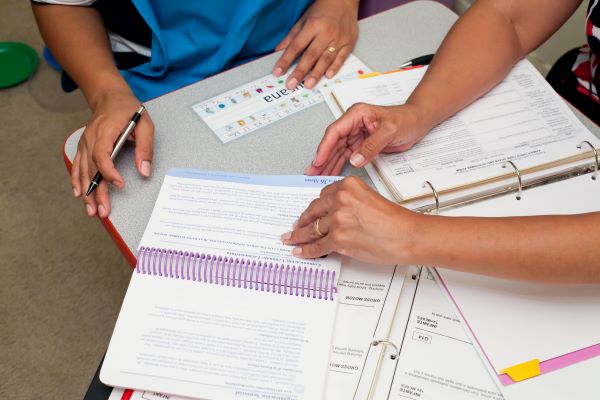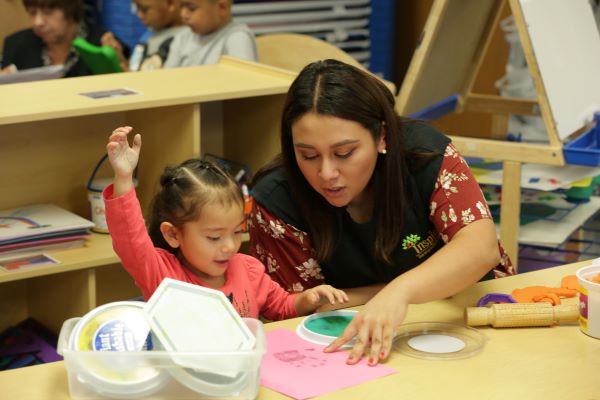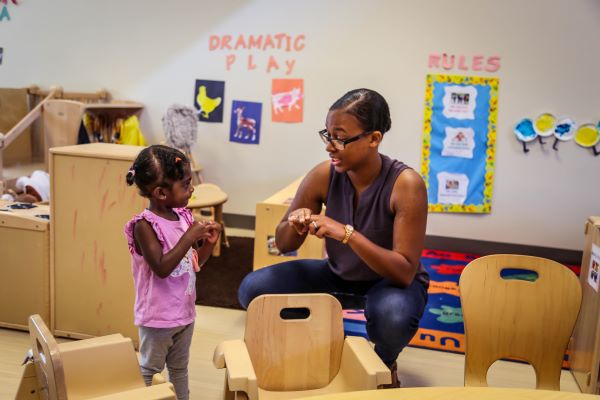Effective programs promote the continued development of languages spoken in the home while facilitating the acquisition of English.
Why It Matters

From birth to 5 years of age, young children who are dual language learners (DLLs) develop a wide range of important conceptual skills (e.g., categorization, classification, narration, cause and effect, logical reasoning, number operations, and spatial relationships) in their home language. As children continue to develop their knowledge in their first language, they can transfer these concepts and skills to a second language.
- Research confirms that it’s important to individualize teaching strategies. Children who are dual language learners benefit from activities that develop their home language while they learn English.
- Studies show that simultaneous bilingual development does not hinder the learning, growth, and development of young children.
- As with any language, the acquisition of sign language by children who are deaf begins with the family. Even if parents and family members of deaf newborns do not know sign language, achieving sufficient language acquisition begins at home and continues in school. “Children who are born deaf or become deaf in early childhood need multimodal and comprehensible language exposure and engagement in joint activity with parents, caretakers, siblings, and others in their social world.”
- When given appropriate access to language, early literacy learning opportunities, and instructional supports children develop communication and early literacy skills similar to their monolingual peers. As education staff create equitable opportunities for children with disabilities who are DLLs to learn and thrive, this means providing resources and teaching strategies that address both special education and bilingual needs.
- Being bilingual is an asset. When listening to language sounds, children who are bilingual have higher activity in the prefrontal cortex of the brain. This area is important for cognitive skills like working memory, directing attention, and impulse inhibition. Other studies show that children who are bilingual are better at flexible thinking. These skills can lead to better mental health and academic outcomes later in life.
- The amount of language exposure children receive between their home language and English affects their fluency and readiness to learn in each language. Children benefit from consistent language exposure, which leads to improved development in both languages and across all learning areas.
- Employing education staff who speak the home language of the children is a first step to providing high-quality teaching and learning services for children who are DLLs. Bilingual staff need specific training to move beyond conversational use of the home language to provide direct instruction and intentional learning.
Connections to the HSPPS
In this section, learn about example indicators for this Multicultural Principle and how they are supported by the Head Start Program Performance Standards (HSPPS). Think about your program and your learning setting. Then, consider ways you already do these practices and ways you can more closely align to improve your practice.
| Example Indicators | Connections to the HSPPS |
|---|---|
Staff use planned verbal and non-verbal strategies to support home language development and the acquisition of English. Staff intentionally use books to promote home language development. Education staff use inclusive practices to promote full engagement in communication and learning activities for children whose home language is ASL/sign language. | Teaching and the learning environment, 45 CFR §1302.31(b)(2) Education in home-based programs, 45 CFR §1302.35(c)(4) Personnel policies, 45 CFR §1302.90(d)
|
| Program leaders use the Head Start Dual Language Learners Program Assessment to improve services to children who are DLLs and their families. | Parent activities to promote child learning and development, 45 CFR §1302.51(a) Personnel policies, 45 CFR §1302.90(d) |
Example Indicators and Practical Strategies
Review practical strategies drawn from research and Head Start programs that promote a programs capacity support home language promotion and the acquisition of English.
Download the Try It! worksheet and choose one practice to focus on for one month. Use the prompts to thoughtfully plan how you will use the practice. The worksheet also includes tips for reflection after using the practice for one month.
Staff intentionally plan to support children who are dual language learners.

Teaching and home visiting practices need to create learning environments that support children’s diversity and use strategies that promote home language(s) and English acquisition.
- The learning outcomes of children who are DLLs are supported with opportunities to interact and learn in each of their developing languages.
- Programs use individual child data, including assessments, observations, and conversations with families to make sure that children who are DLLs progress in each area of learning and development in the Head Start Early Learning Outcomes Framework (ELOF), while also promoting English acquisition and home language development.
- Children who are DLLs are allowed to demonstrate ELOF skills, behaviors, and knowledge in their home language(s), in English, or in a combination of their home languages and English.
- Children with disabilities who are DLLs are provided individualized supports in their home language, in English, in sign language, or in other ways to help them meet their individualized learning goals and communicate effectively. Like their typically developing peers, children with disabilities who are DLLs can learn multiple languages and should have the opportunity to maintain their home language while also learning English.
- Education staff use a tiered approach framework to provide every child with the type and amount of support the child needs. In this type of framework, there are three levels or tiers of support, starting at the bottom with practices that are universal and necessary for all children to learn and develop, then progressing to the provision of more specific, individualized practices for children who need additional support.
Staff use planned verbal strategies to help children who are DLLs develop their home language skills while acquiring English language skills.
- Encourage and support families to speak their home language to their children to create a strong foundation for learning English.
- Learn the languages of the children. If staff don’t speak children’s home languages, they can learn 10–20 “survival words” in each child’s language using the Ready DLL mobile app.
- Simplify or paraphrase instructions. Review how instructions can be simplified for children who are DLLs to follow. Think of ways staff can learn and use simple phrases in the child’s home language to support their learning activities and routines.
- Extend conversations to use more diverse words. Look for ways to ask open-ended questions to keep conversations going. Adults can be good language models in the following ways:
- Encourage infants and toddlers by responding positively to their verbalizations when they attempt to talk. Repeat what they may be trying to communicate and add words or ask questions.
- Listen responsively, and start and continue conversations children are interested in. Help children remember past experiences, and intentionally support learning vocabulary.
- Allow children to code-switch or code mix. When children code-switch, they use all their languages to express themselves as fully as they can. Code-switching helps develop their communication and language skills and learn more. When adults correct code-switching, they send the message that children should only use part of their language knowledge. It also ignores the children’s ability to use translanguaging , or the process using multiple languages to make sense of their world.
 Staff use planned non-verbal strategies to support home language development and the learning of English.
Staff use planned non-verbal strategies to support home language development and the learning of English.
- Allow children to use gestures or other non-verbal strategies to communicate and engage in learning activities. Staff can ask children to use gestures (such as raising a hand or showing thumbs up or down) to communicate interest or respond to questions. This lowers the need to use English to participate verbally, while still demonstrating understanding.
- Use non-verbal gestures to engage with children who are deaf or hard of hearing. In one classroom, deaf and hearing bilingual children created ways to get the attention of someone who is deaf, such as waving in the person’s field of vision.
- Pay attention to the way children show emotion, and respond when a child appears confused, shy, or frustrated when communicating. The encouraging facial expressions and gestures of caring adults help children try new or challenging activities and communicate in their home language and English.
Staff intentionally use books to promote home language development.
- Read books in one language at a time. When adults read in one language at a time, they help children understand and learn new words and ideas. While it is preferable to read in one language, words in children’s home languages or English can be used to clarify and extend concepts. This is especially helpful when children’s skills in the other language are still developing.
- Invite family members to read to children in their home language. Ask parents or family members who speak the home languages of the children to visit and read stories in the language that feels most comfortable.
- Include bilingual books in the learning environment and during home visits to support families, regardless of their language preference, to read to children individually or in groups.
- Include books without words to give families opportunities to share stories, words, and pictures with their child when it’s hard to find books in their home language.
- Home visitors can partner with families and use family photos to create home language stories the child can truly relate to.
- Encourage families to visit the library to find books in their home language, and work with the family to make special book requests to the library if they do not find any.
Practice Example: A Head Start program records parents reading stories in Hmong, Somali, and Arabic and then makes them available to children in the classroom literacy corner. This gives the children authentic examples of the home languages they and their peers can listen to.
Program leaders use the Head Start Dual Language Learners Program Assessment to improve services to children who are DLLs and their families.
- The Dual Language Learners Program Assessment (DLLPA) is used by programs to review and improve the quality of their systems and services provided to children who are dual language learners and their families.
- Program leaders and coaches make sure that supporting practices for dual language development are incorporated in coaching plans as needed.
Education staff use inclusive practices to promote full engagement on communication and learning activities for children whose home language is sign language.

- Partner with families to develop an individualized learning plan for their child, including the use of visual supports, sign language, and hearing aids and devices.
- Share activities and books used during small and large group times with families to allow time to preview and review information with their child outside of the program learning environment.
- Use visual supports including picture boards to teach and reinforce routines and to introduce vocabulary.
- Position children with hearing loss to provide unobstructed visual access to learning activities and to see both the educator and their peers.
- Learn basic sign language (e.g., American Sign Language or Black American Sign Language) and teach children to use sign language to communicate with children and adults in the learning space.
- Encourage children using assistive communication devices or sign language to share their ideas. Repeat and extend their language to build vocabulary and encourage continued participation.
Voices from the Head Start Community
In this section, several staff members — including the early intervention specialist, educator, program coordinator, and services manager — from a Head Start program share their experiences about how they support staff and families’ home languages and cultures in their program.
Help people feel they are a part of the program.
In addition to hiring bilingual staff, educators incorporated other cultures into the classroom by playing music in both English and Spanish, so children learned to speak and learn in both languages. The home visitor observed:
“Employees who are [from] different cultures feel welcomed when they know that there's someone in the center that speaks their language or at least tries to, because I know, sometimes it's hard to have staff that are bilingual. But to them it's the effort that counts.”
Make sharing culture part of everyday activities and routines.
The Head Start program organizes activities so families can come together and share their cultures. For example, children hear what names their peers call their parents at home. The families also bring food, so they see the representation of cultures in the classroom. In this way, children and families naturally learn from each other. The staff observed that by sharing and learning from diverse cultures, the families were more social and engaged with other families outside of their own cultural group. The program coordinator shared:
“I also know a particular site that plays music often … in English, but also in Spanish … It's just an everyday occurrence.”
Understand that cultural responsiveness goes beyond language translation.
Another educator from the program shared that it is not just about translating languages. Instead, it is also about actions that meaningfully bring diverse cultures into the learning environment. A classroom teacher shared:
“One of the classrooms that I was in was predominantly Spanish-speaking children. What I found myself doing was translating into Spanish songs that we sing. My family advocate at the time, he was like, ‘You sing [Selevonda]’ and I was like. ‘What?’ And so, he taught me a song. It's different from English, but it's the same premise behind it: It’s the same people and activity; it is in their language. It’s not just a translation, and so, I’ve started to think about that. When I was a teacher, it’s like, how much am I translating and how much of the culture was coming into the classroom? … [I’m] trying to make those choices to bring the culture in, and not just translate the English version … going a little bit deeper.”
Reflect
Early childhood programs can use the following questions as a starting point — to take a look at the challenges they face and the approaches they might use to promote culturally sustaining and equitable practice across service delivery areas. The questions listed below are designed for self-reflection and critical assessment of practice and can also be used with groups of staff, with families, and with community partners to spark dialogue. In order to go deeper into some topics in a group setting, programs may benefit from session leaders who are skilled facilitators either among their staff or from outside their program.
- How do your program’s policies and procedures support dual language learners using coordinated approaches (45 CFR §1302.101(b)(2))?
- Does your program have written policies on the use of home language and English throughout your program's systems and services? If not, what information is needed to begin? If yes, how are these policies shared with staff and families?
- What policies and practices are in place within your program to support parents’ understanding of first and second language development? How do staff help families develop their child’s home language?
- When it is not possible to hire staff who speak the home languages of families, what has your program done to increase families’ access to the full range of Head Start services and to communicate the importance of family support for the home language(s)?
Deepen Your Learning
Explore these useful resources to learn strategies to give dual language instruction to support young learners.
- Big 5 for All and Children with Disabilities Who Are DLLs
- Supports Classroom Language Models for All Children: Step-by-Step Guide
- Making It Work: Implementing Cultural Learning Experiences in American Indian and Alaska Native Early Learning Settings for Children Ages Birth to 5
- DLLPA sections 3, 4, and 5
- Gathering and Using Language Information That Families Share
- Health Tips for Families Series
- How to Use Bilingual Books
- Importance of Home Language Series
- Planned Language Approach
- Policy Statement on Supporting the Development of Children Who Are DLLs in Early Childhood Programs
- Including Children’s Home Languages and Cultures
- Tribal Language
Read more:
Resource Type: Article
National Centers: Early Childhood Development, Teaching and Learning
Audience: Directors and Managers
Last Updated: February 21, 2024